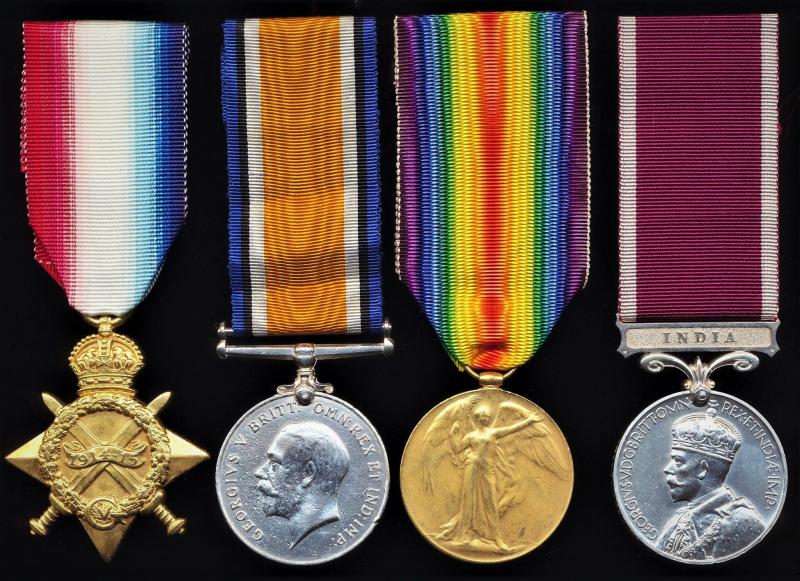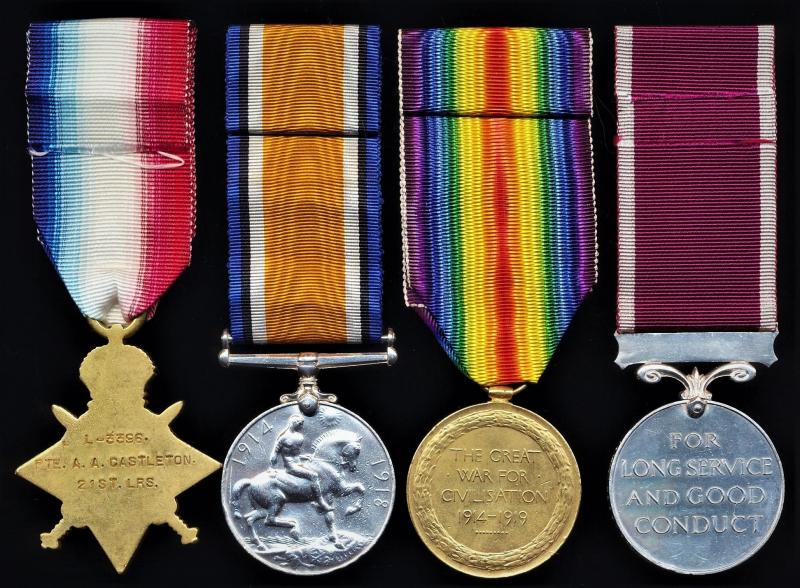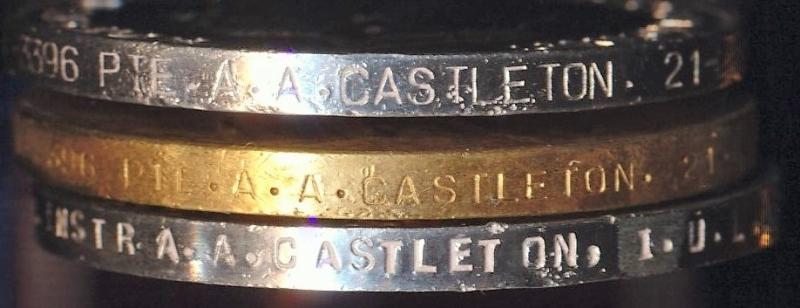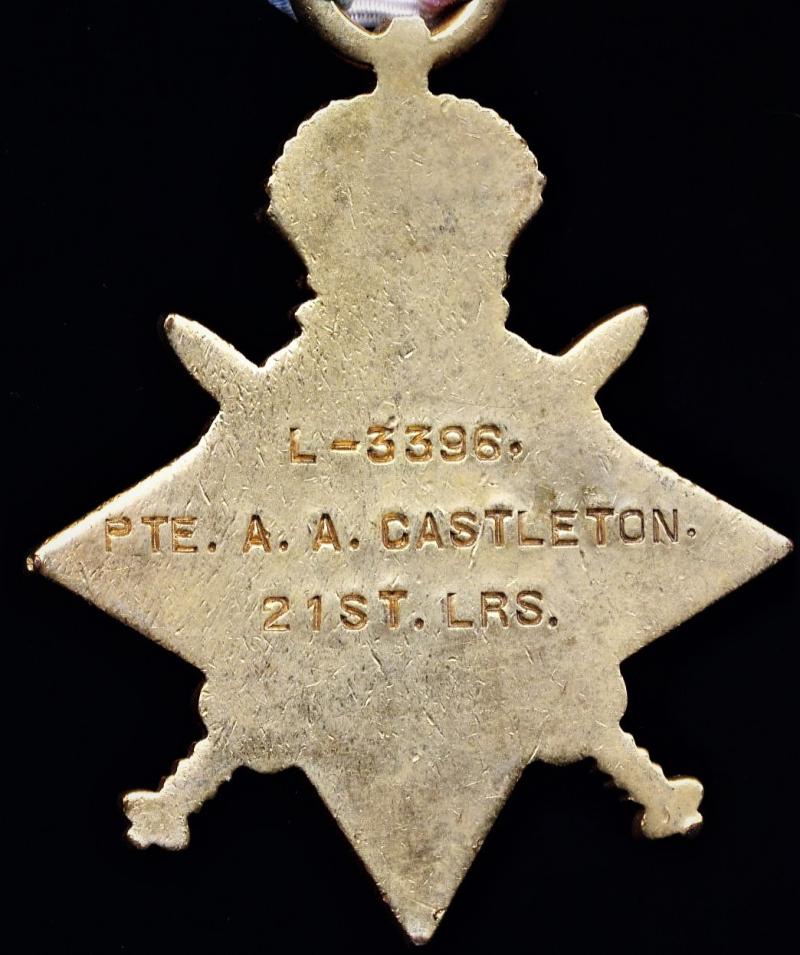A veteran 'Old India Hand' Great War campaign and long service medal group of 4: Staff Sergeant Arthur Alexander Castleton, Indian Un-Attached List, late 21st Lancers)
- 1914-15 Star (L-3396 Pte. A. A. Castleton. 21st. Lrs.)
- British War Medal. Silver issue (L-3396 Pte. A. A. Castleton. 21-Lrs.)
- Interallied Victory Medal (L-3396 Pte. A. A. Castleton. 21-Lrs.)
- Military LS&GC. GV 'India' bar (S-Sjt. Instr. A. A. Castleton, I.U.L. Attd A.F.I.)
Note: The Star with officially re-impressed naming, as issued to recipient in India. The LSGC with 2 x official corrections to unit(s) name on the LS&GC medal
Medals verification: All campaign medals confirmed as entitled per the respective medal rolls of 21st Lancers as cited:
- 1915 Star: WO 329/2518 (entered theatre of war 'Asia', 5 September 1915)
- British War Medal. Silver issue: WO 329/19
- Interallied Victory Medal: WO 329/19
Note: Only 2 x Squadrons of the 21st Lancers were deployed and qualified for the 1914-15 Star, for their action at Shabkadr, near Hafiz Khor (Tribal territory North West Frontier of British India) on, 5 September 1915
The below following account of the battle, whereat Private Hull of the 21st Lancers performed his deeds that won for him the Victoria Cross, was published in the Greymouth Evening Star issue of, 7 December 1915 (courtesy of National Library of New Zealand 'Papers Past'
https://paperspast.natlib.govt.nz/newspapers/GEST19151207.2.46 :
Quote,
LANCERS' SPLENDID CHARGE
DESPERATE FIGHT WITH 10,000 TRIBESMEN.
MOHMANDS ROUTED ON INDIAN FRONTIER.
PESHAWAR, September 9. Thrilling stories of the fighting last week against the rebellious Mohmands on the North-West Frontier are told here by men who took part in the expedition.
The 21st (Empress of India’s) Lancers were engaged, and two squadrons left Risalpur on August 28 in sweltering heat, and marched to Shabkadr, sixteen miles north of Peshawar, to take part, in a concentration of troops sent up to quell the Mohmands (who last rose in 1897). A number of men returned with sunstroke before they reached Shabkadr. In the early morning of September 5 the Mohmands, estimated at 10,000, came down from the hills by the Khar Pass and advanced right into the open, nearly down to Shabkadr village; they were engaged by our howitzer and 11.F.A. batteries. At' nine o’clock, our left being threatened, the two squadrons of 21st Lancers, one squadron 14th Lancers, and one section “M” battery 11.H.A. were moved out. These moved out round Shabkadr village and occupied some foothills to the north. Under a very heavy fire this position became untenable, and they retired to the south a short distance immediately afterwards delivering a charge on a large force of the enemy. Wheeling, the two squadrons charged again, their objective being a dense mass of Mohmands in the lied of the Minchi-Abazain canal. This canal is practicably unjumpable, one or two of the leaders (Colonel J. B. Scriven, commanding, and Captain Anderson) jumping it, but the remainder had to drop in and scramble out the other side. Here the men did great execution with the lance, and all got across. When they emerged from the canal the two squadrons came up under a very heavy fire again at fairly close range from the left. Colonel Scriven gave the order to left wheel and charge for the third time, and it was then that most of the casualties occurred. Lieutenant N. R. Thompson was unhorsed after killing three of the enemy. Captain P. H. A. Anderson disappeared during the charge, and it is the opinion that after being wounded his horse bolted into the enemy. His body was found next day.
Colonel Striven had his horse shot under him, and was on the ground still unhurt with a corporal whose horse had also been shot. The corporal grabbed a spare horse, and both he and the colonel mounted it, and were getting away when the colonel, was shot through the head and killed. The corporal remained with the colonel's body, keeping the Mohmands off by firing his rifle. This N.C.O. was eventually picked up by the squadrons when they rallied and returned to recover the dead and wounded. A great number of the enemy were accounted for in this charge and they retreated from the ground. In all three officers were killed, and three wounded, four N.C.O.’s and. men were killed, and seventeen wounded.
During the last charge a sergeant was unhorsed, and after killing two natives, was grappling with a huge fellow on the ground, their hands at each other's throats, when Saddler-Sergeant. Simpson came up and emptied his revolver into the native, and at the same time was terribly wounded himself, but undoubtedly saved his chum’s life. The adjutant (Captain Learoyd) had his horse shot, and was only fifty yards from the enemy when he was rescued by a shoeing smith and taken, to safety. The action of the two squadrons is spoken of in the highest terms, and their charges saved the day. The Mohmands left the Indian cavalry and concentrated all their attention on the British cavalry, this from, fanatical reasons., It is worthy of note that only two days separated the anniversary of this regiment’s charge at Omdurman, in 1898, from this new achievement.
Unquote.
Arthur Alexander Castleton, fourth son of George Castleton (a Glassblower) and Mary Ann Castleton (nee Glaizer) was a native of Lambeth, London, England, where he was born on 10 September 1892 (baptized at Lambeth, on 25 September 1892). The 1891 National Census for England & Wales, records Arthur, at that time residing with his parents and three older siblings (brothers George & William, together with sister Jane) at, 83 Sturgeon Road, Newington, Southwark, London. By the time of the 1911 Census, Arthur had left home and is shown employed as a 'Barman', at which time he was residing at, his place of work, vide 'Hercules Tavern', 2 Kennington Road, Lambeth S. E. London. Arthur gave up his bar-work, and enlisted in the British Army on, 2 May 1911, being posted to the 21st Lancers, in which regiment he was given the regimental number 3396. Shortly after 'joining-up', Arthur appears to have fallen foul of the military establishment very early in his military career, as he is recorded as having 'deserted', at Woolwich, on 25 August 1911. Whatever the transgression (probably a reaction to his imminent embarkation for overseas service), on return to the regiment, his military service thereafter was that of a model soldier, being awarded the Military Long Service & Good Conduct Medal circa 1930, and his military conduct entered as 'Exemplary' a the time he took his final discharge from the British Army on, 6 July 1931
Arthur spent almost his entire military service overseas in British India, in the period 1912-1931. During the Great War he had the distinction of being a member of, only two squadrons of the regiment, to qualify for the 1914-15 Star, when he 'fought and rode', at the Battle of Shabkadr, on the North West Frontier of India, on, 5 September 1915 - an action which earned the regiment the battle honour 'North West Frontier 1915'. He remained in India throughout the Great War, and post war was transferred to the amalgamated 17th/21st Lancers. Service in British India evidently appealed to Arthur Castleton, as he duly joined the Indian Unattached List, circa 1921, being attached as a Staff Sergeant Instructor to the United Provinces Horse (originally raised as the Gorakhpur Light Horse in 1887) a 'European' volunteer cavalry regiment of the Auxiliary Force India. While serving in India, he married a young (19 years of age) 'Australian' girl, Annie Violet Boyd-Parselle, at Gorakhpur on, 21 December 1922. The couple were blessed with two children born in British India, vide, a daughter, Joan Lilian Castleton (born, 24 September 1925), and a son, Kenneth Arthur Castleton (born 1930)
On return to the United Kingdom in 1931, Arthur took up an appointment as a 'Passenger Road Inspector' with the London Passenger Transport Board. By the time of the compilation of the 1939 National Register of England & Wales, Arthur is recorded living with his wife and two children at, Dagenham. Essex, England. Arthur Alexander Castleton, died at, Chippenham, Wiltshire, England, on, 21 August 1957
1914-15 Star sometime gilded
A most desirable Great War group to a soldier confirmed present at the North West Frontier of India Victoria Cross action of the 21st Lancers
Condition: VF
Code: 22800






